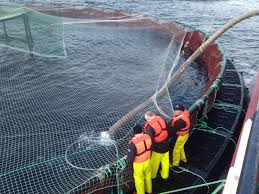Record year for Scottish salmon farms

SCOTTISH salmon farmers produced the highest ever volume of fish last year, with total production of 189,707 tonnes, an increase of 26,890 tonnes, or 16.5 per cent on 2016 figures.
According to the Scottish Fish Farm Production Survey 2017, just published by the Scottish government, marine salmon production was undertaken by 12 businesses farming 226 active sites. This is a decrease of three business and 27 active site compared with 2016.
Freshwater salmon production was undertaken by 24 businesses at 79 sites. The number of businesses operating decreased by two and the number of active sites decreased by eight compared with 2016.
The total number of smolts produced in 2017 increased by 3,258,000 (six per cent) to 46.2 million.
The number of ova laid down to hatch increased by 2.2 per cent to 65.7 million with the majority of these (90 per cent) being derived from foreign sources. In 2017, 339,000 ova were exported.
Just under three per cent of the smolts stocked to Scottish salmon farms were sourced from outwith Scotland, less than one per cent of which came from sources outwith Great Britain. This was a very slight decrease compared with the proportion observed in 2016.
Production figures for this year are forecast to drop significantly, however, with an industry estimate of 150,774 projected tonnage based on stocks currently being on-grown. The decline is attributed to gill health issues in 2017.
The production survey, published annually, reported a decline in the number of people employed directly in the industry – with 1,431 employed in marine salmon production, down 55, and 291 working in freshwater production, down three from the year before.
In 2017, the production of lumpsuckers also increased, with 925,000 (262,000 in 2016). But the number of wrasse produced fell from 118,000 to 58,000 in 2017. Some 1.3 million and 2.9 million ova of each species were laid down to hatch respectively.
In 2017, rainbow trout production was carried out by 23 businesses operating 44 active sites. Total production of rainbow trout in 2017 decreased by 459 tonnes (six per cent) to 7,637 tonnes.
The number of ova laid down to hatch decreased by 2,893,000 (29 per cent) on the 2016 figure to 7,041,000. The proportion of ova from GB broodstock increased to 8.1 per cent of the total sourced.
The number of fish imported to Scotland from outwith GB was 486,000 representing a decrease of 106,000 compared with 2016.
The number of staff employed in 2017 increased by 11 to 132 persons. The number of full time staff increased by 10 whilst part time staff increased by one. Productivity, measured as tonnes produced per person, decreased by 13.5 per cent to 57.9.
There has been a continued interest in the diversification of aquaculture. In 2017, brown/sea trout production increased by 20 tonnes to 61 tonnes.
There was also production of halibut during 2017 but this figure cannot be shown without revealing the production of an individual business.
*The annual production survey of fish farms in Scotland for 2017 was carried out by Marine Scotland Science.
The survey collates annual production data from Scottish fin fish farm sites operated by authorised aquaculture production businesses. The production tonnage obtained is for the wet weight (that is, weight of live fish) at harvest.

